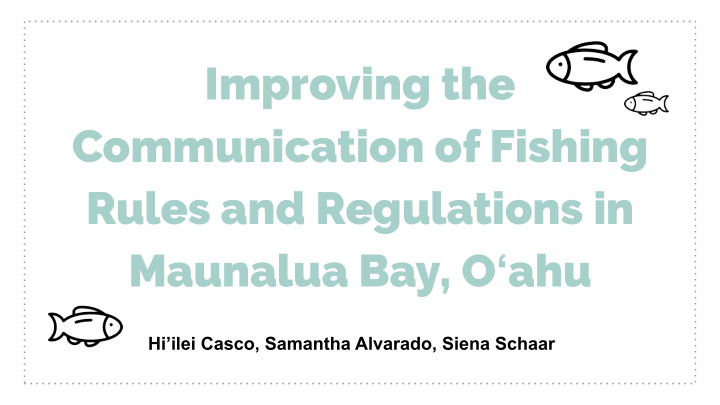



Improving the Communication of Fishing Rules and Regulations in Maunalua Bay, O ʻ ahu Hi’ilei Casco, Samantha Alvarado, Siena Schaar
Introduction Drivers Knowledge Gap Increase in Site-specificity of “outside” user rules groups Problem Reasonings Fishing rule Rule complexity behind rules violations Lack of rule Accessibility education
? Research Questions 1. How can we improve the communication and accessibility of Hawaiʻi fishing rules and regulations to the stakeholders of Maunalua Bay? 2. What are the top 15 significant, fished species in Maunalua Bay? 3. What are the most relevant Hawaiʻi fishing rules and regulations to Maunalua Bay?
Objective Develop multi-generational, site-specific educational materials for Maunalua Bay fishers and users
Our Process Survey + Final Draft Feedback Literature Deliverables Prototypes Review ● Cross reference ● Utilize ● Send draft ● Address edits + survey responses environmental deliverables to feedback ● Fish ecology, literacy, clients for ● Polish design and biology, and communication, comment + content management and social feedback ● Print and ● Social science and marketing distribute to communication strategies clients research
Project Deliverables Audience Deliverable Youth (ages 0 - 8) ʻO Wai Kēia Iʻa? - Children’s book Inexperienced fishers Lawaiʻa-in-Training Handbook Experienced fishers Experienced Fisher Handbook All audiences Maunalua Bay Rules + Regulations Pono Fishing Calendar
! Unique Features Multi-generational Site-specific ● Top 15 “significant” fished species ● Addresses youth to adult audiences ○ NGO survey ● Interactive ○ NOAA Fisher Effort Study ○ Literature Review ● Most relevant fishing practices Design Educational ● Streamlined ● Translated scientific reasonings and ● Limited or defined jargon jargon ● Best practices
ʻ O Wai Kēia I ʻ a? Children’s Book ● Bilingual (Hawaiian and English) ● Highlights Hawaiian cultural importance of fish ● Teaches about life stages of fish and their Hawaiian names
Pono Fishing Calendar ● Both 2019 calendar and blank template (for future modifications) ● Emphasizes spawning seasons for specific species ● Provides pono fishing practices for other species in Maunalua Bay (e.g. turtles, limu)
Lawai ʻ a-in-Training Handbook ● Discusses fish spawning and maturity info > key for reasonings behind rules and regulations ● Highlights important behavioral information ● Shares best practices based off of fish ecology
Experienced Fishers Handbook ● Intended for experienced fish audiences (no descriptions or pictures) ● Highlights reasonings behind rules and regs (i.e. spawning, size at maturity) ● Also encourages best practices
Maunalua Bay Rules + Regs ● Provides scientific reasonings for each relevant rule and reg ● Provides categories for varying types of rules and regs ● Clearly explains value and purpose for each rule and reg
Key Learnings Fisheries Science Social Science ● Regulation size ≠ size at maturity ● Framing of audience (violators vs. ● Reasonings difficult to find learners) ● Rules and regs can be improved ● Language of rules + regs Teamwork + Collaboration Defining Parameters ● Partnership with stakeholders ● Defining “most significant” by ● Roles and responsibilities stakeholder groups ● Interdisciplinary
Regulation Size ≠ Size at Maturity Species Minimum Catch Size Size at Maturity (regulation) ʻOpelu None 9.6” Mackerel Scad Decapterus macarellus ʻŌmilu 10” 12-16” Ulua and Pāpio, Bluefin Trevally Sale size 16” Caranx melampygus Heʻe Mauli 1 lb 2.6 lbs Day octopus Octopus cyanea
Next Steps Material Translations ● Languages of other cultural groups Distribution ● Looking at other methods of distribution ○ Website ○ Other types of deliverables
Mahalo! Any questions? Hi’ilei Casco, Samantha Alvarado, Siena Schaar
Recommend
More recommend